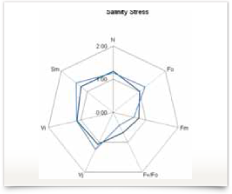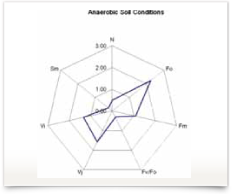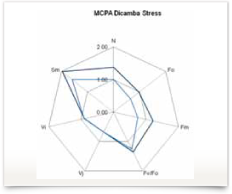ENSPEC uses the Chlorophyll Fluorescence OJIP test to detect the early signs of stress in trees. The test is also used to identify and confirm the predominant stress factors in trees, and can assist in evaluating the degree of stress and the probability of tree recovery.
Tree decline in urban environments can potentially be reduced and managed by assessing tree species and identifying those that are adaptive to the site conditions. ENSPEC can use Chlorophyll Fluorescence OJIP tests to monitor stress levels in trees over time and identify species or phenotypes that are the most adaptable to specific site conditions. This information allows managers to select the most site-adaptable species or phenotypes for propagation and planting.


ENSPEC uses the Chlorophyll Fluorescence meter (commonly referred to as a Handy-PEA or H-PEA) to measure the fluorescence transient rise when a leaf is brought from a dark induced state to a fully active photosynthetic state. When graphed the florescence transient rise shows set stages in the biochemical processes of photosynthesis and energy transfer. These stages are designated as O, J, I and P.
The data obtained from the Chlorophyll Fluorescence OJIP test provides various indicators that can be used to assess the level of stress and the probability of recovery. Two of these indicators are the CF value of the Fv/Fm ratio and the performance index or PI.
By evaluating other parameters in the data (Fo, Fm, Fv/Fo, Vi, Vj, Sm and N) it is possible to determine current stress in a plant such as drought, nitrogen deficiency, salinity or herbicide damage. If a known stressor is alleviated or is modified within the tree over time (as in the case with some herbicides), then the Chlorophyll Fluorescence OJIP test can confirm if the tree is recovering or will go into decline and die.


Transportation of trees from a nursery to a planting site can involve induced stress such as desiccation and heat. ENSPEC can use the Chlorophyll Fluorescence meter to test the vitality of the stock to ensure that the newly planted trees have an optimum chance of survival.
ENSPEC only employs fully trained and experienced operators to conduct Chlorophyll Fluorescence OJIP tests, interpret and analyse the results and to prepare the detailed professional report for the client.
Managers can use the report to make informed decisions regarding the retention or removal of the stressed tree. If the tree is able to be retained the report will assist managers to plan and implement strategies to alleviate the stressors and manage the tree back to health.